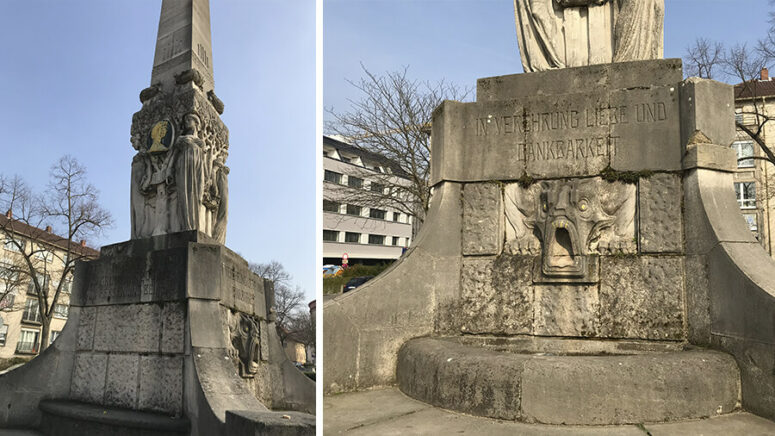
For the sisters of Saint Elisabeth Convent, missionary visits to Western Europe are an opportunity to explore the sites connected with the life of our patron saint, Elisabeth Romanov. Sister Darya Gazaryan reports on her trip to Saint Elisabeth Romanov’s hometown, Darmstadt, Germany.
Grand Duchess Elisabeth came from Germany, and our visits are our window into the context and surroundings in which she grew up. I take great interest in exploring her life. I thought it would be exciting to know about the house where she was born and lived before moving to Russia, and if it still stands. I conducted some quick research and found that some of the sites connected to her life have been preserved almost in their original form. I wrote to the Hessen House Foundation asking for a permission to visit. I explained who we are and why we were interested. They replied that the building was a private residence of the princely family’s descendants and was closed to visitors. However, guided tours were available at certain hours around the park, castle and other related sites of Darmstadt.

The tour guide was enthusiastic and knowledgeable. His great grandfather worked on the estate and met Tsar Nicholas II in person. The emperor gave him a golden watch, which he still keeps as a family relic, along with a large photo collection of Elisabeth’s family. He offers his guided tours in his leisure hours, treating his listeners to exciting stories from the life of Duchess Elisabeth Romanov and her kin.
Her birthplace
Far from being a luxury castle, the house where she was born stands out little from its surroundings. It is still standing and now accommodates an Insurance Services Office. We did not go inside because the only thing that now reminds us of her family is the memorial plaque with the relief of Elisabeth Romanov and some German and Russian text. The plaque was a gift from the Imperial Orthodox Palestinian Society and the grateful citizens of Darmstadt. Remarkably, the Palestinian Society was established before the Revolution. Its first chairman was Elisabeth Romanov’s husband Great Prince Sergey. He was succeeded after his death by Elisabeth herself. The society assisted the pilgrims to the Holy Land with accommodation, food and other routines. It resumed its work several years after the dissolution of the USSR, and its present chairman is Sergey Stepashin, a Russian statesman. It established its office in Darmstadt in 2017 and has since occupied itself with the preservation of the memory of the Princesses of Hessen and the Russian Royal Family.

Elisabeth’s family stayed here for three years after Elisabeth’s birth before moving to a larger property acquired with money from the British Queen Victoria. As Elisabeth’s grandmother, she could not let her relatives occupy a house that she believed was too small and unsightly for people of her position.
Her family residence
Elisabeth’s family moved into a large residence. Elisabeth lived here until her relocation to Russia. The house has not survived and now exists only in photos. They bombed it during World War II because they believed it was army headquarters. It was razed to the ground and could not be rebuilt. It is now a park, with nothing to remind about its past.

A monument to Elisabeth’s mother
A monument by the park is to her mother, Duchess Alice of Great Britain. She was very popular in Darmstadt for her almsgiving and charitable work. When she died at a young age, the residents of Darmstadt put up a monument to her in appreciation for her love and generosity. The inscription reads: “To Alice, the unforgettable Grand Duchess of Hesse and Rhineland”.

The hospital
We also went to the hospital that Elisabeth’s mother was helping during her lifetime. She often brought her children with her to teach them mercy and compassion. The children often brought flowers for the sick to cheer them up.
Today, the hospital looks very modern, but still has a statue of Alice inside. As a Lutheran, she is wearing a large cross. Opposite the statue is a portrait of Margaret Campbell, the wife of Prince Ludwig, her nephew. She helped this hospital extensively after marrying into the house of Hesse.

The Russian church
The Russian church nearby is dedicated to St Mary Magdalene. It was built when Sisters Elisabeth and Alice had left for Russia and married their Russian husbands. They came to visit their parents often and wished to have a Russian Orthodox church nearby. It was completed in 1899 with the personal funds of the Russian Tsar to satisfy the wishes of the princesses. It was built in the Moscow-Yaroslavl style and impresses the spectator with its beauty. Its small size makes it look more like a chapel. Inside, it appears much larger. The great Russian painter Vasnetsov participated in painting its frescos. The local germans named it the Russian Capella. It stands literally on Russian soil. The ground for its foundation was delivered by rail to the nearby station, and then by cart to the construction site. The railway station still exists.

On his visits here, Tsar Nicholas went to this church with Elisabeth and his whole family. The last private worship of the Tsar took place in 1910.
Today, the Church is a museum and a place of pilgrimage. It keeps the icon of the Mother of God of Kazan that belonged to Elisabeth Romanov, the particles of the relics of Saints Job and Amphilochius of Pochaev, and a shroud embroidered by Empress Alexandra. A pontifical liturgy is served every year on the day of the royal family’s martyrdom on 17 July. The sisters who come here on a mission for the first time are welcome here on any day for a guided tour.

Translated by The Catalogue of Good Deeds
Source: https://obitel-minsk.ru/chitat/den-za-dnyom/2020/na-rodnoj-zemle-svyatoj-elisavety-chast-1




